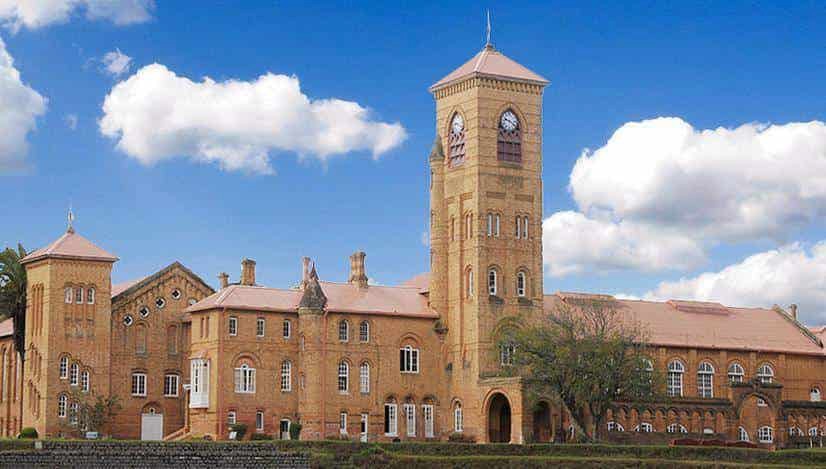CHISHOLM AND THE MOVE TO LOVEDALE
In an earlier post we have seen how Lt General Sir James Hope Grant, Commander-in Chief of the Madras Army threw his weight behind the choice of Lovedale as the site for the expansion of the Asylum.
Work commenced in 1863 and continued till nearly 1871. It was perhaps in the fitness of things that during the years when the new buildings for The Lawrence Asylum named after Sir Henry were being constructed in Lovedale, the Viceroy of India from 1864-1869 was none other than his younger brother, John, 1st Baron Lawrence.
The Girls Asylum was the first to be moved out to Lovedale- on April 24, 1867 while the Boys moved on April 1, 1869.
The buildings at Lovedale, which we admire to this day, were designed by Robert Fellowes Chisholm, (1840-1915) the well- known architect of his time, who had made a big name for himself at a young age.
He specialized in the Indo-Sarcenic style. The characteristic feature of this style was a synthesis of Muslim designs and Indian materials which became very popular in British India during the late nineteenth and early twentieth centuries.
Chisolm chose to design the buildings at Lovedale in the traditional Italiante style, more common in England than in India. It was said, “All his buildings had been constructed in oriental styles with oriental ornamentation. The Lawrence Asylum was realized in the Italianate style fashionable in England”. The rationale for this departure from his usual practice was attributed to the fact that this building was for the children of soldiers of the British Army personnel, the community it served was European and hence its architecture should be as well. The Chapel is designed in the Italian Gothic style, and is a two storied construction forming three sides of a quadrangle a feature of which is the campanile, 130 feet in height.
The chapel referred to here is our present Large Hall. This used to be the Old Chapel till the new one was built much later in 1911, the one near the current Girls School.
A campanile - in architect-speak is a bell tower usually attached to a church. Notice this memorable picture from the 1920s.
We are indeed fortunate to have the recollections of George Webster, whom we have met before, when he described the early years at the Asylum at Ootacamund.
He recalls the actual shift from Stonehouse to Lovedale. Webster writes, “I remember well the day we removed to Lovedale in 1869. The big boys marched the distance, but we, nursery boys travelled in carts. Previous to starting, at about 3 p.m., our tea was served, and on arrival at Lovedale each was given a loaf of bread. We suffered from great thirst after the journey, and eating the bare bread and no provision seemed to have been made of drinking water –at least, I was not aware of any-so fell to drinking the water that trickled in infinitesimal quantities from a barrel"
He went on to say, "The buildings at Lovedale were but half completed and work was being pushed on vigorously. There were over 500 convicts whose services were requisitioned for this purpose. The foundations of the tower were stated to be 15 feet deep and this I quite believe. We had a mangle in use at Stonehouse and the boys always washed their own socks, etc., but large articles of clothing were give out to the ‘dhobi’. This was moved to Lovedale, but continued in disuse in the stone passage till 1871 or so, when it finally disappeared into stores where, I have no doubt, it rests till the present time.
The "convicts" referred to by Webster were the Chinese prisoners from Neduvattam. We will cover them in more detail in a separate blog post.
We are also informed by Webster: " The even tenor of our lives was, within a few months of our taking possession of the new building was rudely broken in upon by the untimely and greatly lamented death of Mrs. Annie Burrows in 1869, and in her, we nursery boys, lost our best and kindest friend. How shall I ever forget her many little nameless acts of kindness and of love? She was shortly after followed by Mrs. Bliss (the Rev. Principal’s lady), who died at Ootacamund and was buried in St. Stephen’s Church-yard. The big boys were permitted to attend her funeral.”
There were glad tidings too. Thomas Burrows, a teacher married Mary Stack on 4th of July, 1870, the earliest recorded marriage in Lovedale - being solemnized in the Old Chapel.
It is evident that much of the construction of the new buildings at Lovedale and the shifting of the asylum from Ootacamund took place under the first Principal’s watch. Rev. Whitehouse’s successor was Rev. T. Bliss, who managed the asylum from 1868 to 1871.
Taking the liberty of interjecting some humour into what otherwise makes heavy reading, one might say, tongue firmly in cheek, that the occupants of The Lawrence Asylum on shifting to the beautiful new buildings and the much larger campus in Lovedale must have felt they had moved from Stonehouse through Whitehouse to Bliss!
We would love to hear your comments!!








